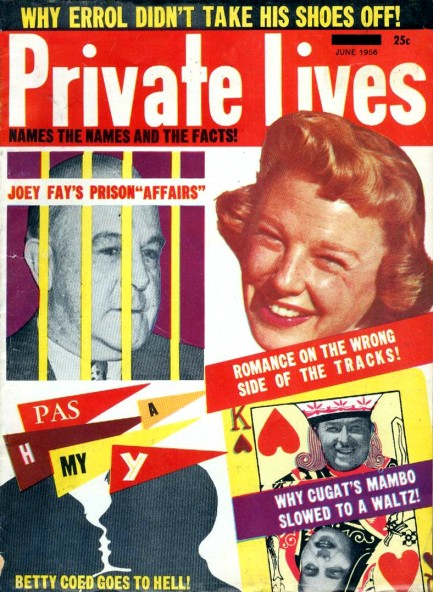| Intl. Notebook | Jun 1 2011 |


This issue of Private Lives from June 1956 with its cover story about Joey Fay teaches us the basic facts of plausible deniability as it works in the political arena. Fay was vice president of the A.F.L. International Union of Operating Engineers based in New York, and in 1945 he was hit with an eighteen-year sentence to Sing Sing Prison for extortion. Within months rumors sprang up that even though he was behind bars he was still running rackets in New York City. A second scandal involving Fay's involvement in crooked horse racing finally prompted some clever reporter, curious who was relaying directives between Sing Sing and NYC, to come up with the genius idea of requesting a list of his visitors. That list turned out to be pure dynamite—it was a roster of practically every prominent east coast politician and official within a two-hundred mile radius. We’re talking the majority leader in the state senate, acting lieutenant governor George Wicks, a former state supreme court justice, state senator William Condon, the mayor of Jersey City, the former mayor of Newark, and on and on. Eighty-seven callers in total, whose visits comprise the “affairs” Private Lives speaks of on its cover.
The embarrassing revelation produced three results. First, the politicians and officials who had visited Fay were forced to concoct highly improbable excuses that the public nevertheless had to accept because nobody knew the exact content of their conversations. Wicks explained his visit this way: “I never consulted or talked with Joseph Fay about anything else but labor conditions in the counties I represent.” See how that plausible deniability stuff works? The second result of the scandal was that Fay was transferred 250 miles upstate to Clinton Prison in Dannemora, NY, where conditions were not nearly as nice as at Sing Sing and he was considerably harder to visit. And third, public officials nationwide stopped visiting criminals in prison. Go and figure. And if there was a fourth result, possibly it was this: a generation of New York voters learned what every generation of voters always re-learns—politicians are exactly as corrupt as lack of scrutiny allows them to be.
| Vintage Pulp | Sep 10 2009 |






































































